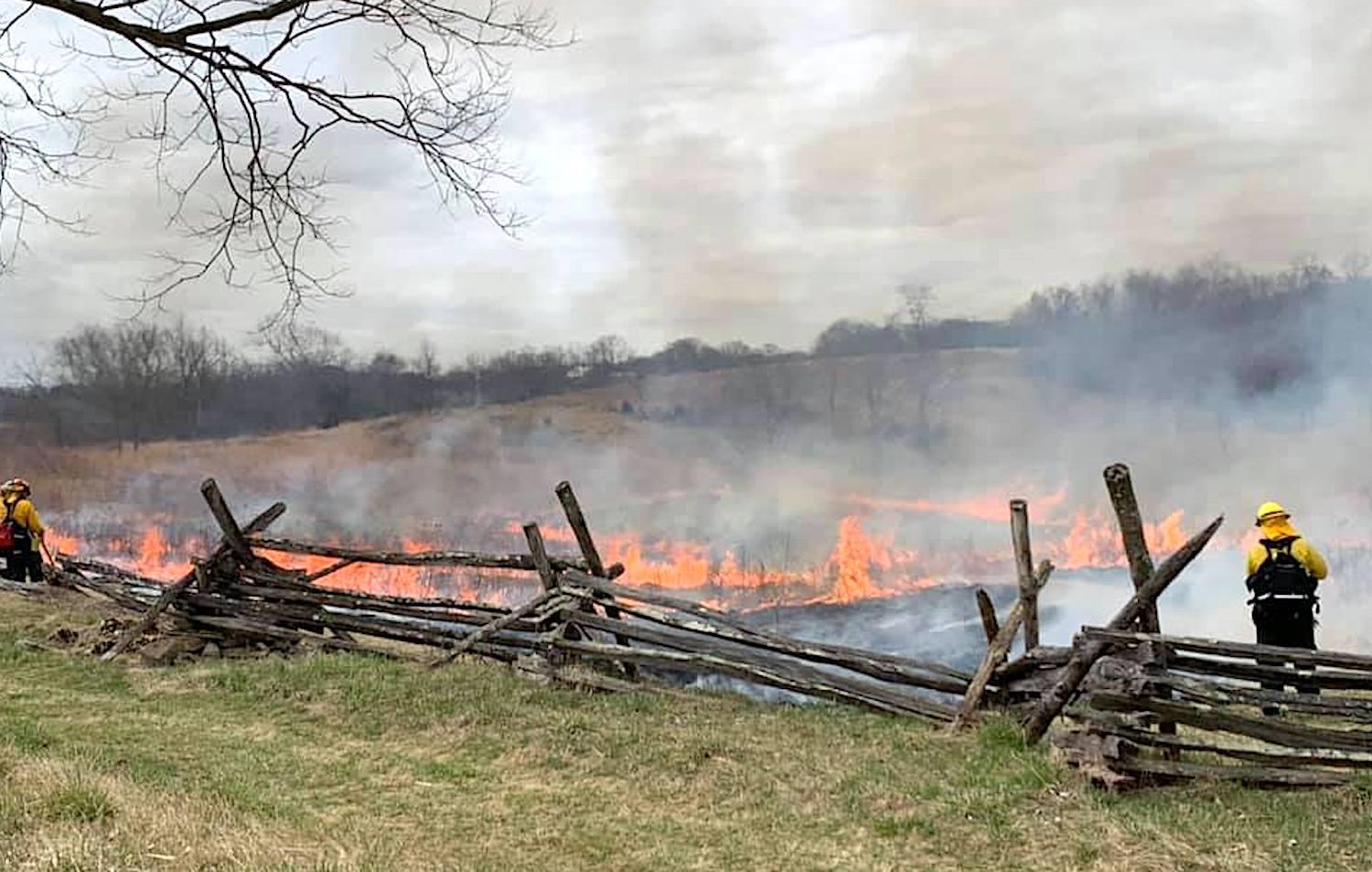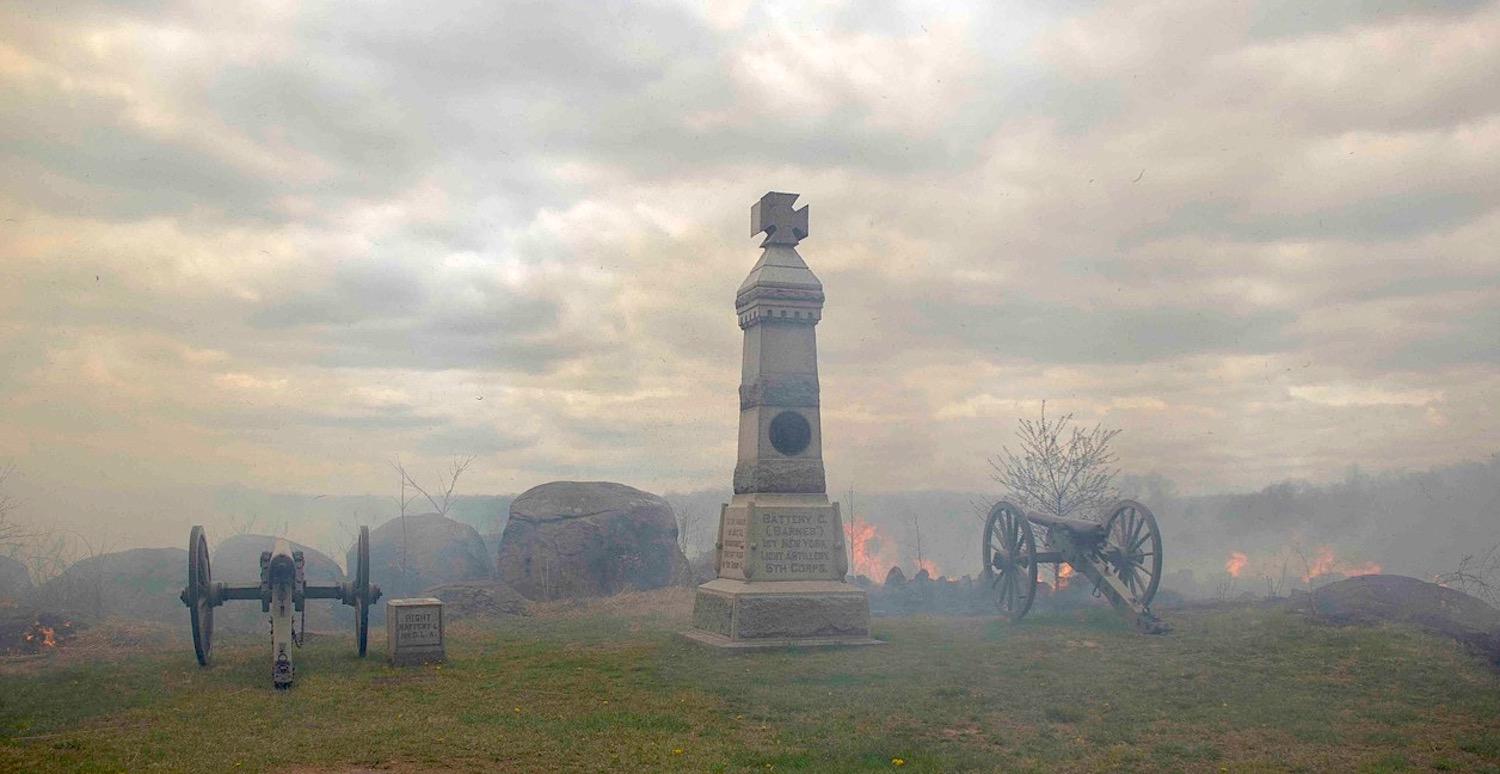
Prescribed fire is a useful tool for battling invasive vegetation at places such as Antietam National Battlefield/NPS
Battling Invaders With Fire At National Battlefields
Prescribed Burns Create New Fights at National Park Battlefields
By Jessica Andreone
Saratoga National Historical Park captures the echo of two American Revolution battles that were fought on a pastoral slice of upstate New York 244 years ago. The Continental Army’s victory against British forces not only marked the first time a British army had surrendered, but it pivoted the American Revolutionary War in favor of the colonials and forever changed the history of the United States.
It has been generations since blood was shed on this former farmland near Stillwater, but now the battlefield is facing an invasion of a different sort. Where armed forces once ran across rows of freshly harvested crops, hikers now walk up and down hilly meadows that outline the old fortification walls that used to divide agricultural pastures.
The only hints giving way to the past are educational signs and cannons on display. Within the bumpy grasslands, native white saucers of Queen Anne’s lace and pink petals of milkweed are facing off against invasive stands of autumn olive and spotted knapweed. These plants were introduced after the war and their spread is a continuous attack—one that routine prescribed burns have failed to completely stop.
In 1985, Saratoga NHP was the first battlefield in the National Park System to set land on fire while under supervision, otherwise known as a prescribed burn. Battlefield sites perform burns not because the local ecosystems naturally depend on fire, but instead to stop the growth of woody plants to preserve a scene similar to that during the time of combat. Since Saratoga’s initial success, prescribed burns are a staple tool to maintain sites across the United States.
“Our objective is really to keep the battlefield looking as close as it did to when the soldiers would have seen it during the battle in July of 1863,” said Jason Martz, communications specialist at Gettysburg National Military Park in Pennsylvania, which began routinely burning fields in 2014.
This past April crews at Gettysburg did two prescribed burns ranging in size from 30 acres to 50 acres. Just like other battlefield sites, most of the fires have been done by National Park Service Wildland Firefighters with the help of state conservation departments.

Gettysburg National Military Park is one location that uses fire to subdue invasive vegetation/NPS
The use of fire by the Park Service to cope with invasive vegetation is not a new approach to managing landscapes.
"Historically, fires occurred as part of the natural cycle of a variety of landscapes including prairies, wetlands, savannas, and woodlands. Fires helped to maintain the natural succession of these ecosystems. Prescribed burning as a management tool has historically been important for maintaining and enhancing native landscapes," said Shawn Duke, a senior staff ecologist with Cardno, a global engineering and environmental consulting firm. "
"It has been used for centuries, with early records of use by Native Americans prior to European colonization. Not only does prescribed burning recycle nutrients sequestered in dead plant material, but it aids in controlling undesired woody plants and herbaceous weeds," he added.
Such burns also can improve wildlife habitat by allowing native plants to reclaim the land, said Duke.
According to Linda White, biological technician at Saratoga NHP, burns are scheduled five years in advance and are done every two to three years. Before fire is applied, the selected area is mapped out and bird nests are removed from the plot. Remaining wildlife temporarily flees the area once squads start torching the area. Since the crews who manage the fires on the East Coast work in a south-to-north fashion, northern parks like Saratoga and Gettysburg are some of the later parks to undergo treatment. This leaves a narrow window of opportunity for fires to take place before most migratory birds arrive and vegetation starts to regrow for the spring season.
The process of completing a burn is a slow and cautious one. Firefighters walk along sections of the park that are to be burned, drizzling liquid fire from a drip torch onto dead vegetation. This tool is a can of fuel that is poured from an elephant-trunk like nozzle that ignites the liquid as it dribbles out. Firefighters with this tool can restrict the flames to the burn area and oversee the project vigilantly for any potential hazards.
Depending on how fast crews work and the weather, a site can miss out on a prescribed burn for a designated year. Besides storms, relative humidity—the amount of water vapor in the air compared to how much the air can hold— and winds determine if a fire can be safely managed. If the relative humidity is too low or winds too strong, the flames can easily get out of control. Though the air is drier in the spring, it’s best to burn plants before seeds are produced.
“Depending on the species, the number of invasive plants will go down if you do it at the right time,” said White. The problem is each invasive species can reproduce at different times of the year. There is always going to be a plant that has already spread its seed.
The spotted knapweed (Centaurea stoebe) at Saratoga is one of those plants. It can stand 40 inches tall and produces 30-40 thistle-like purple flowers that bloom from black-spotted bases. The flower releases heat-tolerant seeds and has a long, deep taproot that can regenerate the plant after a burn. When a fire clears a field, there is no competition for sunlight, space, and water. So, it takes over—in New York at least.
White has photos of an area before and after a burn. Before—semi-wooded and brush habitat full of deep green leaves. After—a field dominated by purple thistle-like flowers that have crowded out all other forms of vegetation, supported by roots that make the soil too toxic for native plant growth. Saratoga’s response is spraying thistle-like herbicide that targets plants in the spotted knapweed family.
Contrary to Saratoga’s experience, biologist Christopher Tawney said, burns are fantastic at eradicating spotted knapweed from the Antietam National Battlefield in Maryland.
Though the success of invasive species removal can depend on the surrounding areas. Prescribed burns at Saratoga are effective at eradicating autumn olive (Elaeagnus umbellata), a thorny shrub with green and silver leaves and red berries. But, according to White, it’s never gone for too long because the park’s neighbors have the invasive shrub along the edge of their property.
An important bird area, the Saratoga battlefields contains habitat for grassland bird species such as Bobolink, Prairie Warbler, and Indigo Bunting. Birds eat seed-bearing fruit of autumn olive bushes and spread seeds to previously cleared sections of the park. The result is silvery-green leaved bushes sprinkled throughout the fields of the park while hiking.
Tawney said that though fires at Antietam slowed the spread of spotted knapweed, autumn olive will remain in freshly burnt fields. Crews will return to areas after a burn to cut it down and treat the stumps with herbicide.
Though invasive plant species still break through defense of prescribed burns, this method of field conservation is more efficient than the old form of hillside brush management.
White said that in the mid-1980s the park had mowed the slopes of the meadow and workers would chop down shrubbery with brush cutters. “There were a lot of tractor accidents over the years,” she recalled.
Before burns, Gettysburg recruited public help. “There might be a dozen or two dozen volunteers just manually hacking away at things,” said Martz. So, the NPS needed to investigate other avenues of management.
Though the war against autumn olive and spotted knapweed is ongoing, prescribed burns remain an effective tool. Without setting acres of land on fire, the remaining hints of bygone battles might have been erased by reforestation. The success of the prescribed burns has allowed for the preservation of historic sites where soldiers fought on American soil.

 Support Essential Coverage of Essential Places
Support Essential Coverage of Essential Places
Comments
How about using goats? They will eat just about anything.
Queen Anne's lace is not a native to North America. It is considered "naturalized" but it's native to Europe and Asia and it's invasive.